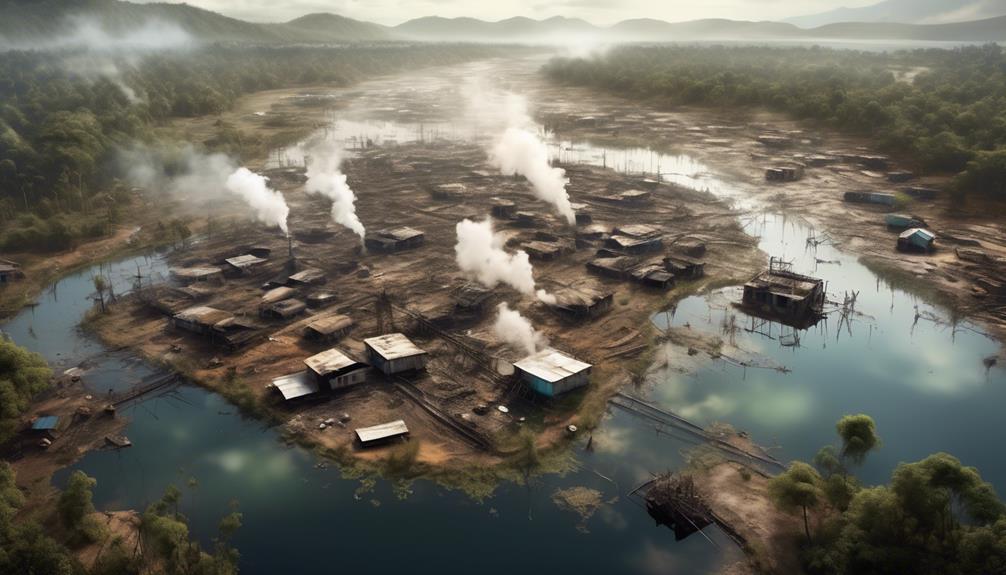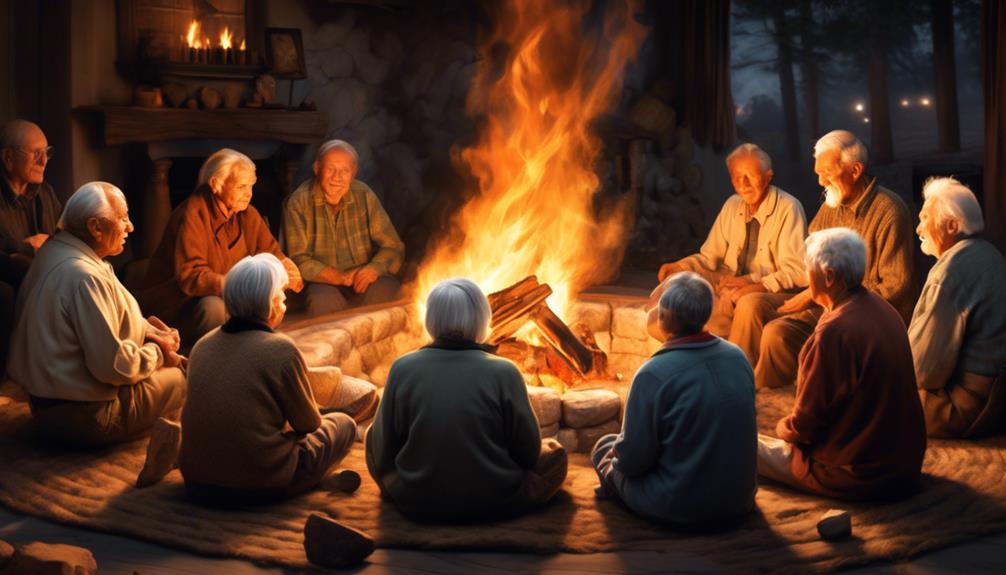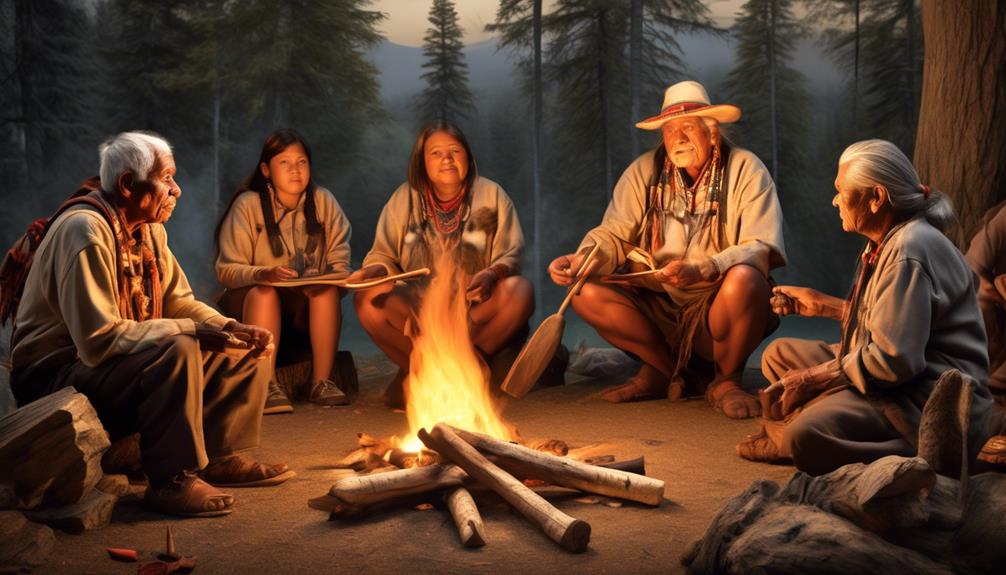Exploring the intricate issue of why indigenous communities face poorer health outcomes, it is evident that the root causes can be traced back to historical injustices and persistent systemic barriers.
However, the surface of this issue has barely been scratched, and it's only by peeling back the layers of historical trauma, socioeconomic disparities, cultural barriers, environmental injustices, and systemic discrimination that we can truly begin to understand the multifaceted reasons behind this disparity.
Key Takeaways
- Historical trauma and intergenerational effects play a significant role in the poorer health outcomes of Indigenous communities, with colonization, forced assimilation, and loss of cultural identity contributing to higher rates of substance abuse, mental health issues, and chronic diseases.
- Socioeconomic disparities and poverty exacerbate health disparities among Indigenous populations, as limited access to education, job opportunities, healthcare, nutritious food, and social support contribute to poorer health outcomes.
- Cultural barriers to healthcare access, such as language barriers, conflicts between traditional healing practices and Western medicine, lack of cultural competence among healthcare providers, and geographical isolation, further contribute to the poorer health of Indigenous communities.
- Environmental injustices and health risks, such as air pollution, contaminated water sources, and industrial pollution near Indigenous lands, contribute to higher rates of respiratory illnesses and gastrointestinal diseases among Indigenous populations. Improving access to clean water sources and implementing policies to regulate pollution can help address these health risks.
Historical Trauma and Intergenerational Effects
Historical trauma has had a profound impact on the health and well-being of Indigenous communities, leading to intergenerational effects that continue to shape their experiences today. The enduring legacy of colonization, systemic discrimination, forced assimilation, and the loss of cultural identity has resulted in significant health disparities among Indigenous populations.
Research indicates that this historical trauma has been linked to higher rates of substance abuse, mental health issues, and chronic diseases within these communities. The intergenerational transmission of trauma has further exacerbated these disparities, as the trauma experienced by previous generations continues to impact the health and well-being of current and future generations.
However, there's growing recognition of the importance of intergenerational healing and community resilience in addressing these challenges. Efforts to revitalize Indigenous cultures, languages, and traditional healing practices have shown promise in promoting healing and restoring a sense of identity and belonging within these communities.
Additionally, community-led initiatives that focus on empowering Indigenous youth, fostering cultural pride, and strengthening social support networks have contributed to resilience and positive health outcomes.
Socioeconomic Disparities and Poverty

The socioeconomic disparities and poverty experienced by Indigenous communities are deeply rooted in historical injustices and ongoing systemic barriers, impacting their health and well-being in significant ways. The combination of education disparities and limited employment opportunities perpetuates a cycle of poverty within Indigenous communities, contributing to poorer health outcomes. Access to resources and community support also plays a crucial role in addressing these disparities and enhancing the overall well-being of Indigenous populations.
| Challenges | Impacts |
|---|---|
| Education Disparities | Limited access to quality education affects employment opportunities and economic mobility. |
| Employment Opportunities | Lack of diverse job opportunities contributes to higher unemployment rates and economic instability within Indigenous communities. |
| Access to Resources, Community Support | Limited access to healthcare, nutritious food, and social support hinders overall health and well-being. |
Addressing the socioeconomic disparities and poverty experienced by Indigenous communities requires a multifaceted approach. This includes implementing policies that promote equal access to quality education and creating more employment opportunities. Additionally, increasing access to resources and fostering community support are essential in improving the health outcomes of Indigenous populations. By addressing these systemic barriers, we can work towards creating a more equitable and healthier future for Indigenous communities.
Cultural Barriers to Healthcare Access
Examining cultural barriers to healthcare access reveals significant challenges faced by Indigenous communities in seeking and receiving quality medical care. These barriers are complex and deeply rooted in historical, social, and cultural factors, which contribute to the disparities in health outcomes.
The following are key cultural barriers that impact Indigenous communities' access to healthcare:
- Language Barriers: Many Indigenous individuals speak their native languages, which can create communication challenges when accessing healthcare services, leading to misunderstandings and inadequate care.
- Traditional Healing Practices: Indigenous communities often have traditional healing practices that may conflict with Western medical approaches, leading to a distrust of conventional healthcare systems.
- Cultural Sensitivity: Healthcare providers may lack cultural competence, leading to a lack of understanding and respect for Indigenous customs and beliefs, hindering effective treatment and care.
- Geographical Isolation: Many Indigenous communities are geographically isolated, leading to limited access to healthcare facilities and services.
- Discrimination and Stigma: Indigenous individuals often face discrimination and stigma within healthcare settings, leading to reluctance to seek medical care.
Addressing these cultural barriers requires collaborative efforts between Indigenous communities and healthcare providers to develop culturally sensitive approaches, improve language access, and integrate traditional healing practices into mainstream healthcare systems.
Environmental Injustices and Health Risks

Indigenous communities' access to quality medical care is intricately tied to environmental injustices and health risks, which demand comprehensive understanding and proactive solutions. Environmental injustices such as air pollution contribute to higher rates of respiratory illnesses among Indigenous populations. Contaminated water sources also pose a significant risk, leading to higher incidences of gastrointestinal diseases. These environmental factors exacerbate the already existing health disparities faced by Indigenous communities.
| Environmental Injustice | Health Risk |
|---|---|
| Air pollution | Respiratory illnesses |
| Contaminated water | Gastrointestinal diseases |
Addressing these challenges requires a multi-faceted approach. It involves working with Indigenous communities to improve access to clean water sources and implementing policies that regulate industrial pollution near Indigenous lands. Additionally, healthcare initiatives targeting respiratory and gastrointestinal illnesses need to be prioritized. By addressing environmental injustices and the associated health risks, we can work towards achieving health equity for Indigenous communities and ensure that they have the resources and support needed to lead healthy lives.
Systemic Discrimination in Healthcare
Analyzing systemic discrimination in healthcare reveals pervasive barriers to access and quality for Indigenous communities, necessitating evidence-based interventions for lasting change.
Healthcare disparities and racial bias contribute to Indigenous populations receiving substandard care, perpetuating poorer health outcomes. This systemic discrimination manifests in various ways, including:
- Implicit Bias: Healthcare providers may hold unconscious negative stereotypes about Indigenous peoples, leading to differential treatment and neglect of symptoms.
- Limited Cultural Competence: Lack of understanding of Indigenous cultures and traditions can result in inadequate communication and inappropriate care.
- Underfunded Healthcare Facilities: Many Indigenous communities have limited access to healthcare facilities, which are often underfunded and understaffed.
- Geographic Barriers: Remote Indigenous communities face challenges in accessing healthcare services due to distance and lack of transportation.
- Lack of Advocacy: Indigenous patients may face obstacles in advocating for their own care, leading to unmet healthcare needs.
To address these issues, interventions should focus on educating healthcare providers about cultural competence, increasing funding for Indigenous healthcare facilities, and implementing policies to reduce racial bias in healthcare delivery.
These evidence-based approaches are crucial for dismantling systemic discrimination and improving healthcare outcomes for Indigenous communities.
Frequently Asked Questions
What Are Some Specific Traditional Healing Practices That Indigenous Communities Use to Address Their Health Needs?
Traditional healing practices in indigenous communities encompass a wide range of cultural practices that promote holistic healing and wellness approaches. These include herbal medicine, traditional ceremonies, sweat lodges, and healing circles.
These practices emphasize spiritual and mental well-being alongside physical health, aligning with indigenous healthcare interventions that prioritize interconnectedness and balance.
How Do Indigenous Communities View Mental Health and What Are Some Culturally Appropriate Approaches to Addressing Mental Health Issues?
Cultural perspectives on mental health within indigenous communities are often rooted in holistic views of well-being. Traditional healing approaches, such as storytelling, connecting with nature, and community support, are integral to addressing mental health issues. These methods recognize the interconnectedness of mind, body, and spirit.
What Role Do Traditional Diets and Food Sovereignty Play in the Health Outcomes of Indigenous Populations?
Traditional diets and food sovereignty are integral to the health outcomes of indigenous populations. These diets often provide essential nutrients and are culturally significant, contributing to overall well-being.
Emphasizing food sovereignty supports access to traditional foods, promoting physical and mental health. Incorporating cultural healing practices within these dietary traditions can further enhance mental wellness.
Recognizing and supporting these aspects is crucial in addressing health disparities and promoting holistic health in indigenous communities.
What Are Some Successful Examples of Indigenous-Led Healthcare Initiatives That Have Improved Health Outcomes in Their Communities?
We've seen indigenous-led healthcare initiatives that have made a real impact. These programs prioritize cultural relevance, community engagement, and traditional healing practices, leading to improved health outcomes. By empowering indigenous communities to take ownership of their health, these initiatives promote resilience and self-determination.
For example, the Maori-led Whanau Ora program in New Zealand has shown success in addressing social determinants of health and promoting indigenous empowerment.
These models demonstrate the potential for positive change within indigenous healthcare.
How Do Indigenous Communities Incorporate Traditional Knowledge and Spirituality Into Their Healing Practices and Healthcare Decision-Making?
Incorporating traditional knowledge and spirituality into healthcare decision-making is crucial for indigenous communities.
Traditional healing practices, rooted in cultural approaches, play a vital role in mental health and overall well-being.
By integrating these elements, indigenous communities can address health disparities and empower individuals to take an active role in their healing journey.
This approach aligns with evidence-based solutions and fosters a holistic understanding of health, promoting improved outcomes within indigenous populations.
Conclusion
In conclusion, the health disparities faced by indigenous communities are deeply rooted in a complex web of factors. Historical trauma, socioeconomic disparities, cultural barriers, environmental injustices, and systemic discrimination in healthcare all contribute to these disparities.
Addressing these issues requires patience, persistence, and a willingness to confront uncomfortable truths. It is like untangling a knotted rope.
By acknowledging these challenges and working towards solutions with indigenous communities, we can begin to unravel this knot. This will pave the way for a healthier, more equitable future.
Mary is a passionate writer who brings creativity and a fresh perspective to our team. Her words have the power to captivate and inspire, making her an essential contributor to our content. Mary’s commitment to storytelling and dedication to promoting Indigenous culture ensures that her work touches the hearts of our readers. We’re fortunate to have her as part of our team.










